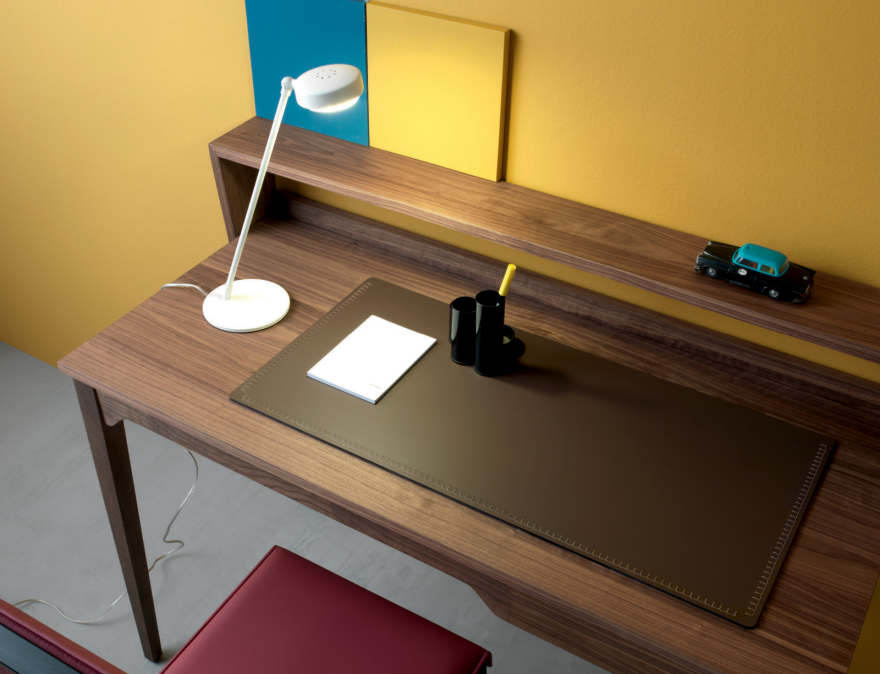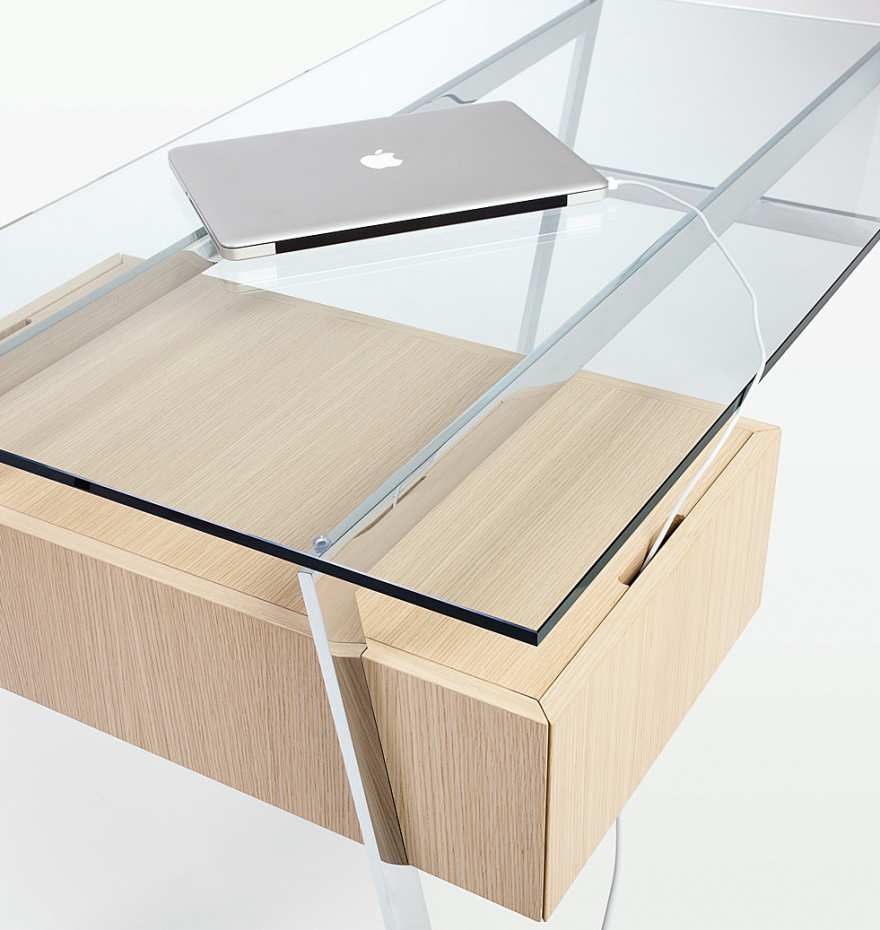This article is part of the Design for Impact series, a collorabation between Core77 and Autodesk focused on designers using their craft to promote environmental and social change.
Growing Goods for Good
Designers and consumers have an urgent challenge to confront in the current discussion around sustainability. How can we distinguish between goods which seem eco-friendly, but actually contribute to a culture of waste, and those that are truly green? Designer Danielle Trofe had to challenge herself to look at every aspect: from prototyping methods, to production materials, to manufacturing processes, to the ultimate disposal of the object and its component parts.
She ultimately came to a very unique solution: using bio-utilization to grow indoor lighting. Designing with living materials, Trofe is building consumer furnishings that truly embody the best of cradle-to-grave sustainability.
![]() The Mush-Lume Table Lamp
The Mush-Lume Table LampWorking with Nature, Learning from Nature
Meet the MushLume Lighting Collection, grown using mushroom mycelium or what the biomaterials company Ecovative – Trofe's frequent industry partner – calls "Nature's glue." Mycelium is the root structure of mushrooms. Along with being the largest living organism on Earth, it's able to decompose organic compounds, filter toxins from soil, conduct energy, act as a natural insulator and provide nutrients to a vast number of living organisms. Using Ecovative's material, which combines crop waste like corn stalk with mycelium, Trofe grows custom lampshades. Once they've completed the growth cycle (4-10 days depending on the size of the lampshade) the material is heated to halt any further growth. The material is lightweight, soft and entirely stable. In other words, it won't 'shroom in your room.
The material matters. From production to decomposition, mycelium feeds the earth rather than stripping it of needed resources. At the stage of disposal, it safely returns to the earth where it once again serves its natural functions. For the purposes of the designer and the consumer, mycelium also happens to be beautiful,, and durable in the long term.
![]() Mush-Lume Hemisphere Light
Mush-Lume Hemisphere LightFrom Materials to Mimicry
Want to know the dirty little secret of design? Nature does it even better than us. As Trofe continues to innovate, she challenges herself to ask, "What would nature do?" This idea has evolved over years of design exploration but it seemed to catalyze for her after reading Janine Benyus' seminal work, Biomimicry: Innovation Inspired by Nature.
"Biomimicry is looking at nature's form, function, and ecosystems and emulating this into human design. Nature has had 3.8 billion years to refine and adapt to the operating conditions on earth. It has found and fine-tuned strategies to deal with the same kind of challenges that humans are dealing with now. We're now looking at these patterns, processes, forms and functions, and emulating them in design innovation. That includes at a very simple form level, like looking at the knee of a grasshopper and considering how it can propel the grasshopper 100 times higher than its own body. How can we use that knowledge in our own applied design? Or we can look at the way an old-growth forest works and how its many symbiotic relationships cultivate competition and cooperation all the while there are no wasted resources. Everything is recycled. Everything is in this closed-loop system," Benyus explains.
"As a designer, you have to respect our shared natural resources," Trofe says. "Would nature create something that would eventually not be able to be broken down into smaller components so that it could be reused or upcycled? It's kind of this common sense thing. It's important to ask the question, 'Does this process or material really make sense in our environment?'"
The MushLume Lighting Collection embodies the value of Trofe's mantra: What would nature do? Nature would use its resources with form and function as the driver while allowing all of the materials to safely return to the earth at the end of their lives.
![]() Mush-Bloom Orb Planter
Mush-Bloom Orb PlanterBuilding to Learn
Working with Autodesk and Ecovative empowers Trofe to continually explore and learn. With Fusion 360, she crafts and plays and explores and tests ideas, using 3D models as virtual sketching tools. What emerges are design concepts built from the inside out.
"The first time I'd worked with a 3D modeling program, it was kind of this Aha! moment of, 'here is a communication tool that works for me.' Because at the end of the day it's how you communicate the ideas that are in your head that matters. Having the right tool set to appropriately do that makes all the difference," she says.
According to Trofe, Autodesk tools also encourage discovery and exploration.
"With Autodesk's Fusion 360, I find that I get into this workflow, and because I'm experiencing an object three-dimensionally, my mind is engrossed in different angles. It's a deeper thought process than a pen and paper," she says.
She also finds a perfect marriage between technology and handcraft in how she makes, and in how consumers experience, her products. "I use 3D modeling tools to create particular tooling parts that are conducive to an environment the lampshades can be grown in, and then we're adding the human touch to it. The tooling is handpicked, satisfying that human touch we deeply crave. So every product we make is just slightly different."
Watch Danielle Trofe walk us through her amazing design process in this behind-the-scenes video!
Partnerships for Growth
"Trofe's a great example of the kind of entrepreneur we love to support. She's pushing the envelope in terms of her materials choice, her use of design technology and the results speak for themselves. Her work is aesthetically so pleasing and also inspires her customers to think about the sustainability of their daily lives. Her work is creative, innovative and hopefully an inspiration for both her customers as well as other designers," says Pam Hochman, Marketing Lead for the Autodesk Entrepreneur Impact Program.
For Trofe, it's the various collaborations that make the work flourish. "Collaborations are extremely important, and a lot of times we ward them off due to competition, trying to protect assets. But collaborating, connecting, and sharing these resources and the knowledge base is the thing that really advances our ideas."
![]() Mush-Lume Cup Light
Mush-Lume Cup LightA Call to Action
"A lot of times we're just so divided in our own little ecosystems that we kind of get disconnected from nature. The thing that's most important to me, and I think of it both as a consumer and as a designer, is I want to establish a deeper connection with people and their things, especially the things that we see every day." This connection is formed by creating a greater awareness of how our objects are made, what they're made from, and ultimately where they will end up.
Trofe strives to inspire other designers to view their work through the lens of a question she hopes will become a centerpiece for design in the near future:
What would nature do?
![]()






















































































